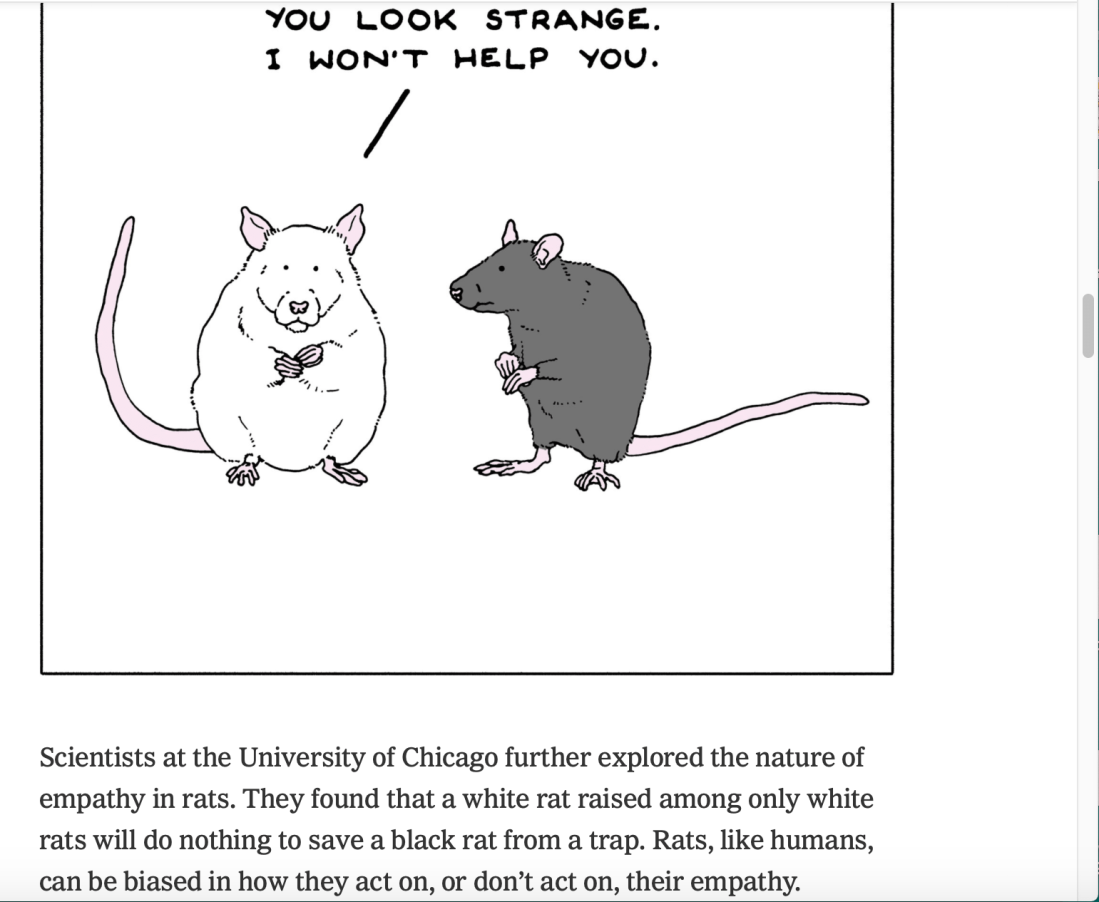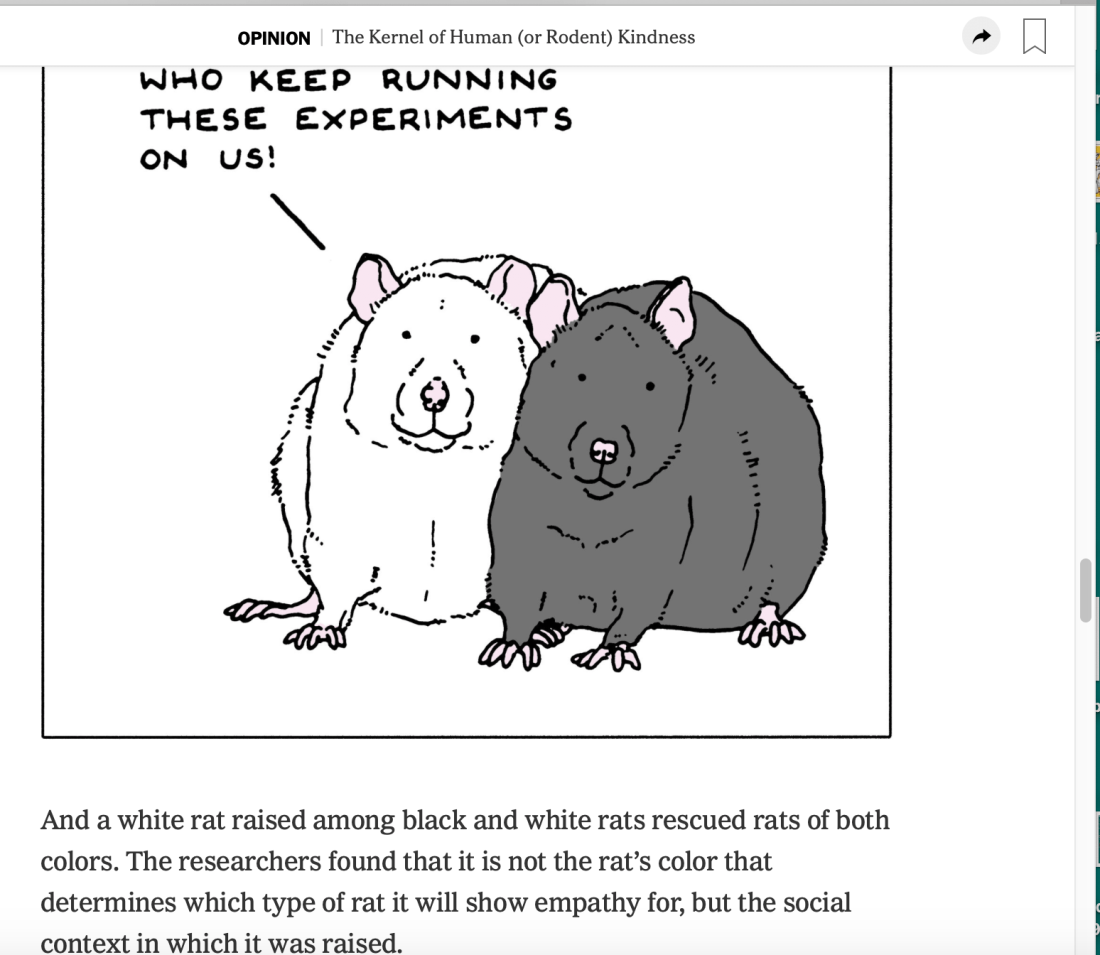
Greetings, welcome back, and best wishes to everyone for a very happy and healthy New Year.
I hadn’t planned this additional post on race, but I came across what I feel is a wonderful piece of Op-Art on the topic in The New York Times. Some of you may recall it, but even if you do, I hope you’ll use the link above to revisit it. It’s worth several readings, I believe.
And it’s followed by another serendipitous example that I find enriches the topic.
Writer and illustrator Henry James Garrett has created a wise and amusing morality tail/tale that’s titled “The Kernel of Human (or Rodent) Kindness.” I’m pretty sure the fair use police will prevent me from reprinting the piece in its entirety, as I would love to do, so I’m including a few screen shots (if they work–I’m getting better at this technical stuff, but each new challenge is fraught with the fear of mishap).
Please keep in mind that this is just a sampling, probably unfair to the creator because it doesn’t capture the richness of the artwork and messaging in its entirety. But here we go…




Please do click on the green New York Times link above to see Garrett’s entire work. It will just take you a minute, and I really think you’ll enjoy it.
________________________________
Before we leave the topic of race for now, I’d like to add the second serendipitous piece. One of a number of special friends I’ve reconnected with as a result of this blog is a Master Gardener. I was unfamiliar with this term, but I’ve learned that Master Gardeners are volunteers who have undertaken considerable training in the science and art of gardening. They, in turn, share their expertise by educating the public on gardening and horticulture.
My friend had the additional responsibilities involved in serving on the Board of Directors of the Master Gardeners organization in the area in which he lived. He had a lot of experience in organizational work as well, having had a long and successful career as a Manufacturing Manager for a major US corporation, where his responsibilities included diversity training.
But my friend, who is African-American, grew tired of his fellow board members’ failure to listen to his ideas (as well as impatient with their lack of organization).
He was comfortable with what he had to offer but felt his presence on the board was that of a “token”: he was there for show, but not for substance. So he resigned his position–and received a very gracious letter from one of the few board members who clearly recognized that his absence would be felt.
In an email explaining to me what had happened, he wrote of the other board members: “I really don’t think they know the difference between Affirmative Action and Diversity. Gardeners generally practice diversity every time they plant a flower, but they probably wouldn’t make the connection. There are a number of reasons we plant a diverse garden.”
I found his words both poetic and a fine metaphor for why our society is strengthened by our growing diversity.
So from rodents to gardens, I feel we’re surrounded by lessons about how much we have to gain by being empathetic toward one another and celebrating both our differences and our commonality as human beings.
I hope to hear from you about whether my serendipitous finds resonate. As always, I depend upon your thoughts, experiences, and stories…For those of you who are new to this blog, you must go way down the page to find the comment box in which I hope you’ll enter your response. Thank you!
Annie
Annie,
As you suggested I clicked onto The NY Times link and was able to view the whole Op-Art article. It did add to what you had written, so it was very interesting to see the whole thing. Well written with good message.although I don’t know about the anthropomorphism used here.
Don
LikeLiked by 1 person
Good point, donthedoctor. And I was so enchanted by the piece that I didn’t do my usual due diligence re: what we really know about rats, their abilities to differentiate colors, and the choices they then make. But as you said, it’s a good message. I’m glad you found it interesting.
Annie
LikeLike
Annie — love, love the rats! Thanks, too, for the NYT reference — informative, as others have noted. And I very much appreciated your friend’s experience with window dresssing. I had a job like that once and quit in a big fat fit (oh so young, oh so very stupid). With the itty bitty wisdom that comes with aging, though, today I’d probably try to discuss/teach my former bosses. Or better yet, I’d send them to your blog! Keep writing, Annie. We need your voice.
LikeLiked by 1 person
Hi, Denise–
So glad you not only love the rats, but gave them time to unfold their story beyond my limited screen shots. Oops, I’m being anthropomorphic! I’ll rewrite: Gave their creator time to unfold HIS story…
As for my friend’s experience with what you aptly call window dressing, I think it’s a tough call to know what to do in such circumstances. In his maturity, he was able to write an eloquent letter of resignation. I understand your regrets about your “big fat fit,” but it seems a likely response from a very young person to what I surmise was a pretty awful situation.
And once again, thanks so much for your generous comments about my blog. I am most appreciative of your encouragement.
Annie
LikeLike
Love “The Kernelof Human (or Rodent ) Kindness”. It is a joy to read ,look at the illustrations and remind ourselves what a blessing it is to have diversity. I just witnessed my son-in-law become a U.S. Citizen. It was so wonderful seeing all the people and their families of different backgrounds and ages,participating together on such a joy filled day. It reminded me againhow much in common we humans have. I felt that there was hope in achieving the American Dream. Freedom and Justice for all
LikeLike
What a wonderful, uplifting comment! Congratulations to your son-in-law and family–and congratulations to us for getting a fine new American. You’ve provided an important reminder that what we are currently living through is transitory, and better days are ahead. You’ve also reinforced my hope/belief that we can/must find common ground. Thank you so much!
Annie
LikeLike
Annie, hi, I’m new to your blog…love this piece (and the NYT link). Next thing to do is look for the “follow’ button.
LikeLiked by 1 person
Welcome to annieasksyou! I’m delighted to have you join me and will check out your blog shortly. I now have a “thing” about rats, which you’ll see if you read my post about my friend Peter. I just donated to Apopo, an organization that does incredible work with “ratHEROES.”
LikeLiked by 1 person